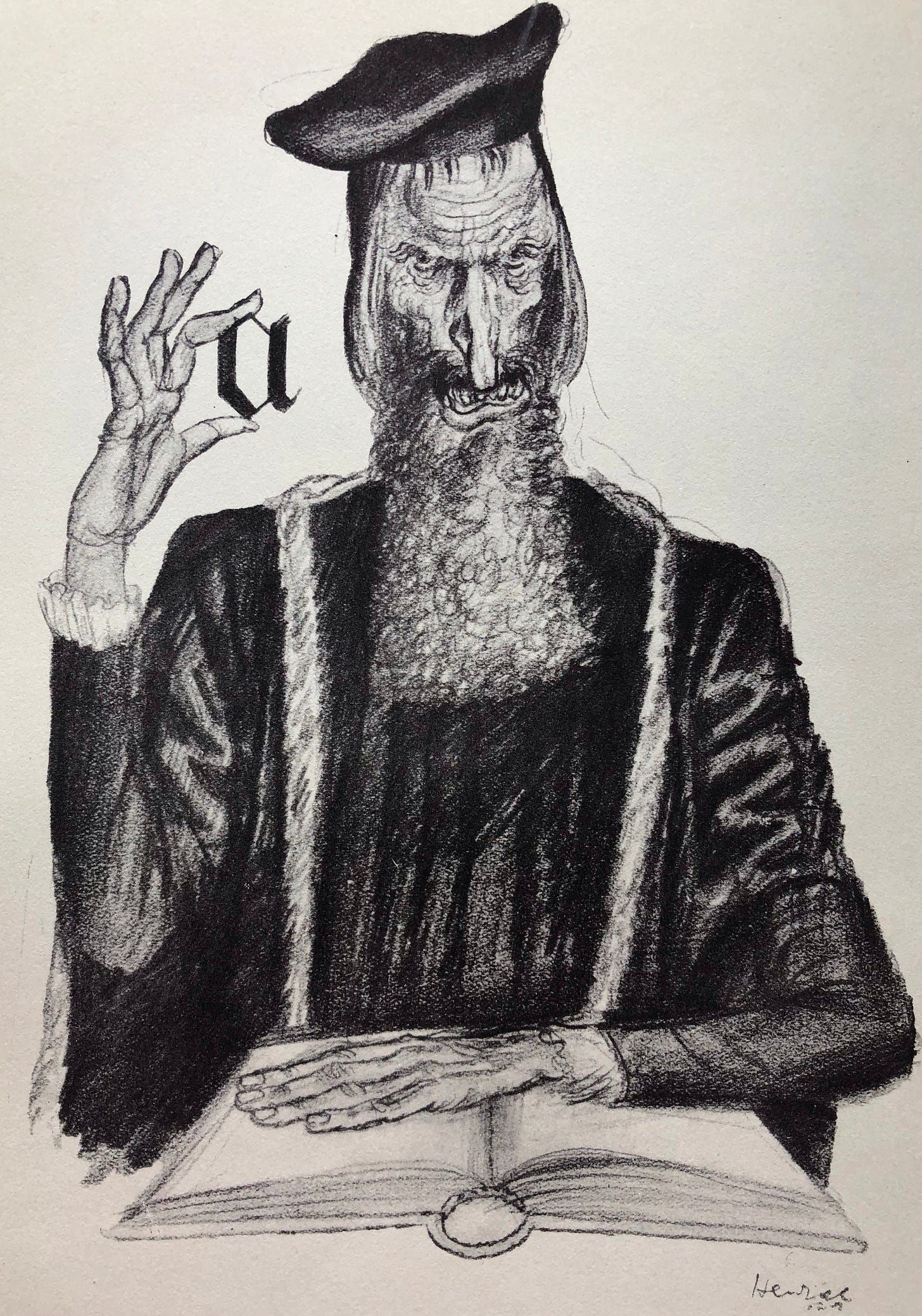
In the literary café on Paris’ Rue des Cascades sat a writer. It was nine in the morning, the summer was still young. You could already feel the heat descending on the city but the street was shaded between flats and high garden walls - it smelled of damp earth and rotting plant debris. In front of the writer lay a large notebook. The right page was covered with written text, and the left one too. However, these were loose notes and lavishly pasted over with colored papers with more notes. The writer looked serious. Occasionally he would note something down at lightning speed. Or he scratched out a sentence or a paragraph. Sometimes he said something to a man reading at the table next to him.
A few hours later, I listened to a speaker at the Society for the History of Authorship, Reading and Printing’s congress at the Bibliothèque Nationale de France. A contented smug man. He told the audience how he bought himself a new and expensive fountain pen for every upcoming book to be written. He also told the audience how in the nineteenth century a veritable battle had been fought between the supporters of the quill - Gustave Flaubert was one of them - and the propagandists of the new steel pen. I knew Flaubert wrote with a quill, but not that he did so on principle, let alone for the preservation of civilization.
Back on my sunlit street in Belleville, I drank a glass of beer on the now-crowded terrace of the literary café. At my small table, without asking, a young woman sat down. She pulled an elegant laptop out of her bag and started typing furiously. She looked angry but wasn’t.
‘What are you writing about?’
‘Mon blog littéraire.’
The tone made it clear that further conversation was not appreciated. There was work to be done. There followed half an hour of speed typing, erasing, whispering, and typing. And then she was done. She pushed a button. Publish. She walked inside, paid, and left.
The romantic in the café - this is how one imagines a writer. Poor, misunderstood, and stubbornly working on his masterpiece. Would the writer hand in his text as a manuscript? To a publisher, he expected to recognize his genius in a jungle of erasures and innumerable additions in the margins and loose papers? It could be. Marcel Proust’s manuscripts looked no different.

[Manuscript of Marcel Proust - one of these authors who start seriously after their book is set]
The successful academic writer in his elegant suit, who had his work probably transcribed by his secretary, and who stood orating with visible pleasure in front of his international audience - there were at least five hundred people in the room and there was much laughter and loud applause.
The young writer who self-publishes her work and who can see exactly how many readers a day look at her texts, how long they read, and what they read. She can track their comments and publish them along with her own. Texts that are not fixed because she can change or delete them at any time. No publisher, no editor, no critic, and probably no income - only with tens of thousands of readers a day does a blog become interesting for advertisers.
Three different writers. A literary man who sits in a café, creating entirely in the romantic image, an academic who boasts of his expensive fountain pens, a self-publishing writer who gives herself to her audience unfiltered by a publisher or an editor.
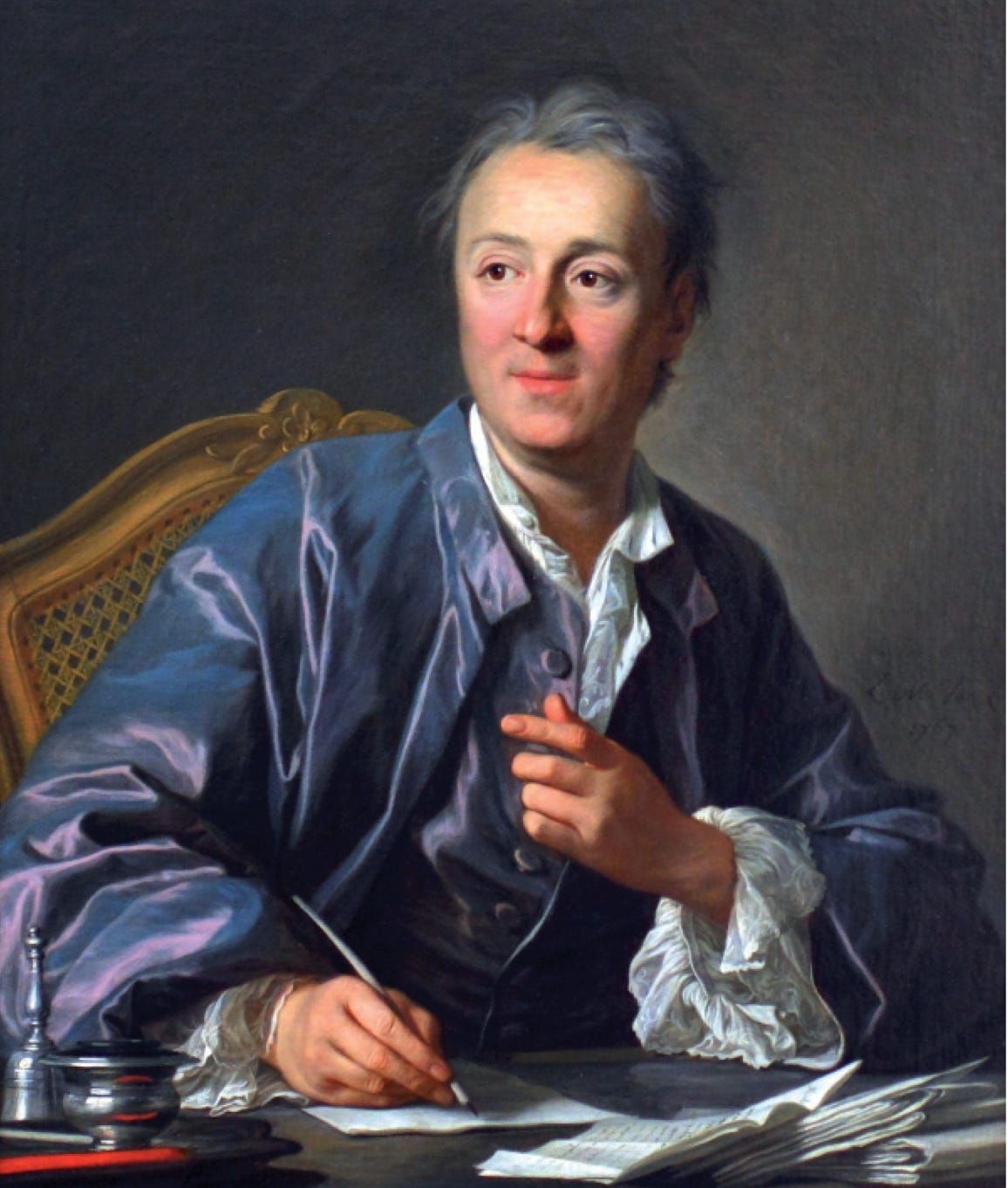
In Diderot’s Encyclopédie, écrivain (writer) and author have different meanings. A writer writes literature. All other books are written by authors. By that definition, the famous seventeenth-century playwright Racine is a writer, the physicist Newton an author. A sensible distinction, although some writers are also authors, like Umberto Eco - and Diderot himself, as he wrote a number of fine novels in addition to his Encyclopedia.
Cookbooks, travel guides, and textbooks are often produced on commission or at the publisher’s request. By an author. Writing a cookbook is easier than writing a novel. Although it does not pay more or better per copy sold, the author can often make a reasonable living from it. Writing a non-fiction book takes months rather than years, and sales can be better estimated by the publisher. And so, as an author of cookery books or history books intended for the general public, you can plan an oeuvre and make a comfortable living.
Diderot says I am an author. If someone asks me what I do in my daily life, I will never answer that I am a writer, although I published a few short stories. But if I ever publish a modest novel besides my thick non-fiction books, I will call myself a writer. That has to do with writer status. The writer is admired and rightly so. Barring exceptions, a published writer has come a long and arduous way. She or he wants to communicate something in a personal and polished style, a story, a view of the world or an emotional outpouring. That is difficult as anyone who has tried knows. The gap between the vision and its literary elaboration is infinitely wide and deep.
Publishers too know how difficult it is to write a novel. Manuscripts arrive at publishers’ offices every day. There are hundreds every month and for all Dutch publishers combined, there are many thousands every month. Fewer than one in a thousand make it into a book. To help persistent aspiring writers, there are writing courses and freelance editors. If this doesn’t work out, and the writer is still convinced that she or he has written a masterpiece, there are ‘publishers’ where you pay for publication.
The writer who does so, by the way, may be right. William Blake was considered a lunatic by his contemporaries and printed his work himself. Now we see him as an outstanding poet and an eighteenth-century forerunner of the Romantics. Rejected by a leading publisher, Marcel Proust financed the publication of the first volume of A la recherche du temps perdu by a lesser-known publisher. Afterward, the editor who had initially rejected him - ‘who on earth wants to read a book in which the protagonist spends 50 pages waking up’ - recognized the writer’s genius. The editor, André Gide, was a famous writer himself. He would call Proust’s rejection the stupidest decision of his life.
The image of the writer who must create because he cannot help but follow his inner voice emerged in the early nineteenth century. This image emerged from the ideas of French philosopher and writer Jean-Jacques Rousseau. Rousseau opted radically for the individual. The greatest task for a human being is to develop himself, according to his subjective insight and, if necessary, against all established opinions. Many writers had - and still have - this romantic vision of authorship. This was also fuelled by the dual attitude of the masses towards the individual, the artist. Ants hate the cricket but cannot do without its songs. As long as the ant had an idea about the rules of art, there was little ambivalence in the relationship between the artist and the public. The cricket might have an unfathomable talent, he still had to work hard to master these rules.
Before Romanticism, there was no individual expression against the odds. Up to and including the eighteenth century, art standards were fixed. Talent was indispensable, but art existed by objective rules that could not be broken. The writer’s talent was measured by his ability to create an original vision within that framework. With talent and practice, you became a writer or a poet. Writing was a profession, and writers and poets were rewarded.

[Writing for money: Gregorio Leti, inspired by devils produces book after book - critics know how to deal with his work]
The romantic view of writing meant that the material side of writing faded into the background. The profession became a vocation. Writing for money was not done; you wrote because you had to, because you were an artist. Success was suspect because a genius could not be understood, let alone appreciated, by the masses. Authors and journalists, ‘Grubstreet’, were looked down upon because they abandoned their vocation out of conformism or laziness.
Of course, money was also a concern for the writer. The critic and failed writer Cyril Connolly aptly described the dilemma. According to him, a writer had be rich, or at least comfortabel off, and, if he was married, his wife should leave him alone.
‘Domestic happiness hinders the writer, as does nagging about the rent, the price of bread, or the ringing of the doorbell. There is no worse enemy of art than the pram in the hall.’
Writing takes time, and time is money. He who has no money has no time to write literature. Instead, he writes in the newspaper. As Connolly did throughout his life. Writers often write about money. The most famous example is Balzac, who thought of nothing else. James Joyce and, in the Netherlands, Louis Couperus wrote nasty letters to their publishers about their fees. Not that they were happy to admit it. Writers want as much money as possible from their publishers and envy each other’s sales figures.
The problematic relationship between idealized bohemia and harsh reality, where food must be on the table every day, is universal. Whether you were a poet in classical Rome, a late-mid-century historian, a playwright in the Golden Age, or a poet in residence at Amsterdam’s Café Zwart, in all eras and cultures writers were - and are - accorded a special gift that distinguishes the artist from the masses. It involves style, and the ability to see and put into words things that most people only notice after reading about them. The writer knew his special status. Poets like Horace and Virgil knew how much they were worth. They dealt with the Roman elite who admired and rewarded them.
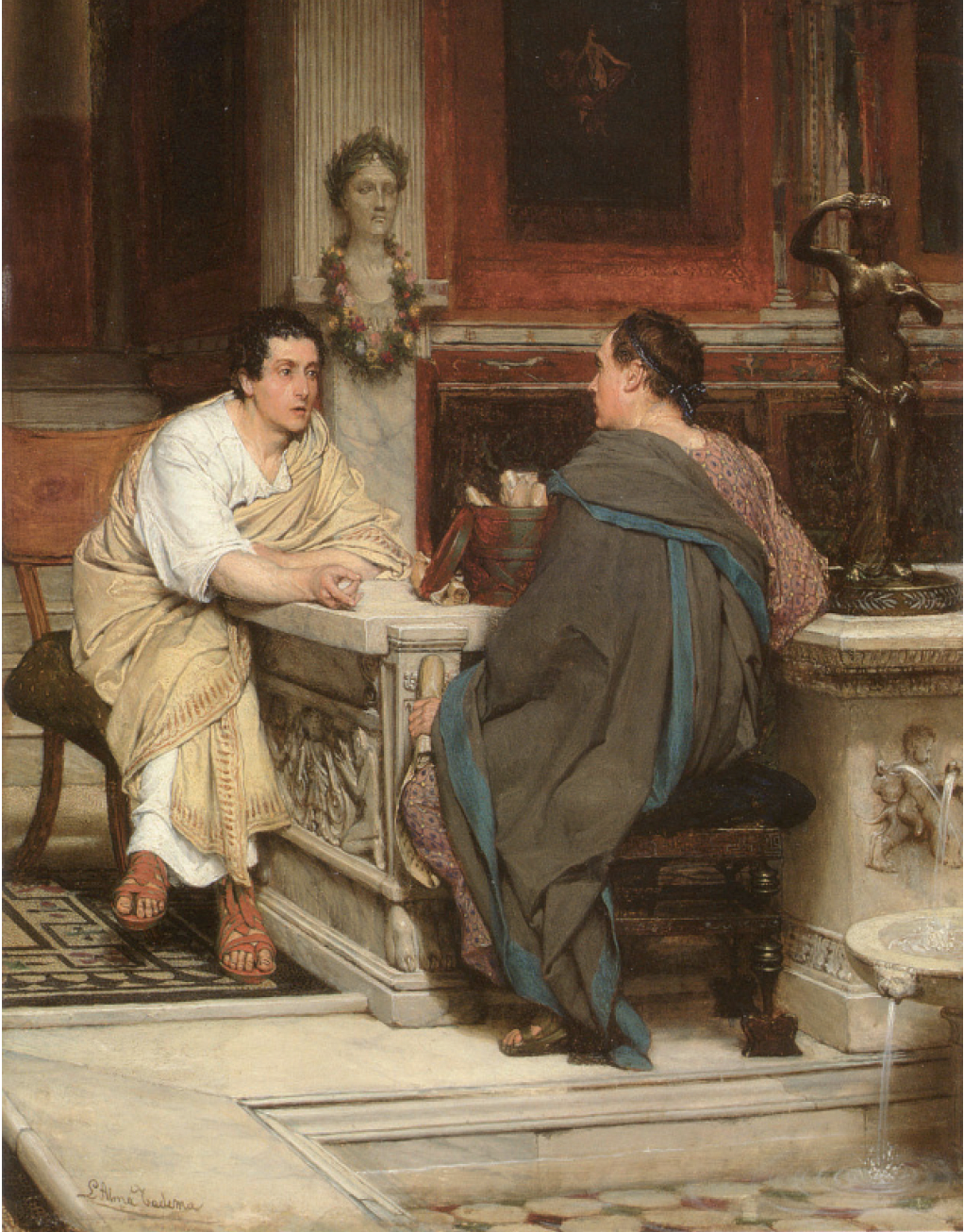
[Cicero in conversation with his friend and publisher Atticus]
Of course, not every Roman poet received a country house from an admirer to write in peace. Martialis amused his patrons in exchange for a meal or a bottle of wine. He eventually received a cottage in the country from Seneca’s heirs. The writer conferred status on his patron; the patron ensured the writer could write by contributing to his livelihood. We started calling it mecenat after Maecenas and that system remains important today. There are still private patrons - Dutch writer Gerard Reve had one in Rotterdam shipowner Ludo Pieters. However, patronage has largely been taken over by the government, which provides grants and allowances.
In classical Rome, talent gave access to the circles that mattered. These were rich people with taste who appreciated you and listened to your readings in the privacy of their homes or villas. The public read the poems on sale in bookshops and displayed in public libraries. There were no printed books, but commercial studios where slaves sat diligently transcribing poets and historians’ work existed. Successful books were produced in editions, comprising many dozens to hundreds of copies. In this way, classical writers also reached a large audience.

[Jean Miellot offering his work to his patron Philip of Burgundy]
The writer’s position changed dramatically after the fall of the Roman Empire. Text multiplication disappeared, along with literacy. The writer became a singer, a bard or a minstrel. The written text became a memorized recitation. In the later Middle Ages, we occasionally see a scribe depicted in a book. More often than not he is on his knees at the feet of a prince or cardinal who absently petting his hunting dog while the scribe humbly offers him his handwritten book.
Even before the printing press was invented, books were again mass-produced, by hand, just as in classical antiquity. Professional copyists could be found in all of the larger towns and learned poets and scribes like Petrarch transcribed books as quickly and beautifully as professionals. Writers became influential once again, helped in this by the flourishing writing culture in the cities.
The impact of the printing press in the 15th century is still debated. Researchers see the printing press as the driving force behind major social innovations, including the Renaissance and the Reformation. However, others consider its role negligible. For one group at least, the printing press had major consequences and that was the writers. Within twenty years, the handwritten book was driven to the margins of the book trade. Professional book transcription almost disappeared within one generation. It was replaced by ‘real’ writing and editing instead of reproducing what was already there. The opportunities thus created for budding creative and learned writers can hardly be overestimated. If you look up the biographies of the late-classical or early-medieval authors from any collection of medieval books, you will see that the vast majority belonged to an old and rich family while a small minority came ‘from nowhere’. After 1500, things were different. Most of the upcoming writers are children of illiterate farmers and artisans. Genres in which such authors excelled were theology and the natural sciences but there were also poets among them. They were self-confident gentlemen, who often had themselves portrayed in their books. Not on their knees at a prince’s feet like their earlier medieval colleagues. Instead, standing in front of their bookcase or sitting at a writing desk, always wearing a fine coat with the fur collar of a scholar. They earned their money at university or with publishers for whom they translated, edited, corrected, and wrote books. Of course, such boys, and occasionally girls, were also discovered before 1500 by a local priest. However, they did not go to universities but disappeared into the convent - if they had the temperament for it.

[Michael Maier, with a book and a sword]
Novels were not written before 1600, although endless knight’s tales like Amadis de Gaulle were as popular as Game of Thrones is today. Poems and plays were the main literary genres, followed by the novel, which took off in the 17th century. The writer was usually not rewarded by the publisher unless you consider the gift copies he received from his publisher as fees. And he naturally received money if he co-paid for his book’s printing and was thus his own publisher. Writers were not nearly as ubiquitous or prolific as today but the relative scarcity of original texts did not lead to well-paid writers. Erasmus described how in the early sixteenth century, when he was not yet famous, he worked for the Venetian publisher Aldus Manutius. The meals were meager and often consisted of spoiled herring washed down with sour wine. Later he lived for many years in luxury with his Basel publisher and friend Johann Froben, but by then he was famous. Still later on, he received large sums of money from princes and potentates and he no longer had to worry about money at all.
In the fifteenth and sixteenth centuries, there were jobs for writers in the church, at universities, and for princes. These were often positions with an income and without many other obligations so that the writer could spend his time doing what he did best: writing. He who writes stays - in the sixteenth century it was discovered that you also remained known to posterity if you were written about. So monarchs hired a historian like Froissart or a famous poet like Ariosto. His Orlando furioso contributed greatly to the eternal fame of the D’Este family, Ferrara’s rulers.
The Dutch Republic had no princes or noble houses in the Golden Age. How a writer could make a career in bourgeois Amsterdam in the early seventeenth century is shown by Joost van den Vondel. Vondel’s parents were Baptist refugees from the Southern Netherlands who ended up in Amsterdam. He became a member of a literary society for Flemish exiles, D’Eglantier, where people read each other’s poems and acted. There he met his first publisher, Dirck Pietersz, for whom he composed captions for a collection of moralistic pictures starring animals.
Vondel wrote occasional poetry for rich Amsterdammers’ marriages and funerals, eventually emerging as the Republic’s greatest poet and playwright of the Golden Age. He owned a hosiery shop in the Warmoesstraat but the sums he received for his poems and plays were his main income. Once he established himself as a playwright, he stopped writing occasional poetry except for the city council and a few foreign monarchs. He created his plays not for a patron but for all Amsterdammers and was rewarded for it by the city council. He received a position at the city’s lending bank, which gave him plenty of time to compose poetry. Vondel regarded wealthy merchants as equals.
aThe money Vondel received for his poetry was not paid for his work but a recognition of his exceptional talent. During the 17th century, occasional poems became a genre for breadwinners paid by the page. Erudite merchants and officials - think of Hooft, Huygens, or Amsterdam mayor Six - composed such poems themselves or had Vondel as a friend. If you had money and were not erudite, you hired someone to write a poem. The now-forgotten Anthony Janssen wrote hundreds of marriage and mourning poems. You can still find them in our libraries. They often still have their original covers of gold or fur decorative paper.
For a writer, it could be lucrative to act as a publisher himself or co-pay for his texts’ publication. The Utrecht schoolteacher Simon de Vries is an example of a well-earning author who let publishers pay him per quire, acted asi a publisher himself, and traded in books. Those who wanted to earn money by writing wrote thin pamphlets - or very thick history books and sermon collections. Writing plays or a volume of poetry takes much more time than transcribing or paraphrasing someone else’s work.
It was not that easy to appeal to a fickle patron for a reward. You dedicated your collection to a wealthy merchant, a mayor, or the city council. If you were lucky you would get money, thirty or fifty guilders, at least a thousand euros in today’s purchasing power. But it was still a wait-and-see situation. If you were talented, you could write pamphlets. These were thin; you had pamphlets with eight or twelve pages of text - about 6000 words. You wrote a text like that in a day or two, earned two or three guilders, and a day later the pamphlet was in the printer’s window or distributed along the streets. If it caught on, such a pamphlet was reprinted many times. Publishers in Amsterdam, Antwerp, or The Hague were always looking for suitable texts, thousands of which appeared in some years.
Clergymen supplemented their salaries with sermon collections, professors wrote down their lectures, and dissertations for their students. They also wrote erudite poems in Latin, as well as history books. A special case is the well-known (in the Netherlands!) poet Jacob Cats. Cats was not only an excellent poet but also a corrupt official and a money-grubber. If the introduction in one of his books is true, where Cats claims that more than 250,000 copies of his work had been sold, he earned tens of thousands of guilders, many hundreds of thousands of euros converted to our times. If the numbers and assumptions are correct, he was easily the best-paid writer of the century world wide. Detailed evidence such as archival documents is lacking. However, the design of Cats’ books shows that he had a firm finger in the pie. That alone indicates that he was also financially involved in his books.
Science resided in Leiden in the Republic in the seventeenth and eighteenth centuries, thanks to its university, which was considered among the finest in Europe. Although a fraction of what was printed in Amsterdam was printed in Leiden, Leiden publishers reached a much larger audience. Their authors and audiences lived in all corners of the world. The Elzeviers published modern and controversial writers such as Galileo Galilei. Their editions were and are found in libraries and collectors worldwide, from Mexico to Japan.
Anyone who publishes an academic work now will usually not receive money for it. Those who wrote specialist work in Dutch even have to bring enough money in the form of grants to pay for its production. The seventeenth-century scholar wrote in Latin. He did not have to bring money, but he did not get paid either. At most, the publisher gave him gift copies of his book. There is at least one famous exception to this. The most important seventeenth-century book is Discours de la méthode by René Descartes. That appeared not in Latin but in French, in 1637, and not with the two biggest and most famous publishers of its time, Elzevier or Blaeu.
Elzevier would not give more than three or four copies to the author, and in Amsterdam, where Blaeu was based on the present Damrak, there was a severe plague epidemic in 1636. And so it was that the solid but relatively unknown Leiden publisher Joannes Maire entered into business with the French philosopher. French historians praise the generosity of the famous philosopher - after all, he waived any compensation! This is true. But the philosopher, who was far from famous at the time, asked for no less than two hundred gift copies, or more than ten percent of the first edition. Not only did this allow him to send a copy to everyone who mattered, including the king of France and numerous cardinals and bishops, but it also meant that he effectively pocketed a hefty fee in kind before even one book had been sold. The author granted the publisher permission to print four thousand copies. These were never produced ; many years later, the first edition of 1000 copies was far from sold out. No letters and few archival records have survived about Joannes Maire, so we do not know what the publisher thought about his star author, let alone what he thought of his remark at the end of the book, where Descartes complains about the illiterate typesetters who made many mistakes while the tormented writer could not correct them. A curious comment, since Descartes stayed in Leiden during the printing of his book. He stated somewhere else that he was mostly busy spending long mornings lying in bed pondering about philosophy.
The early eighteenth century saw a new genre that resembled the pamphlet: the journal. Scientific journals had existed since the mid-seventeenth century but they only summarised and commented on books. The new Spectators did not have headlines like modern journals but, like today, they covered a wide variety of topics. For readers, it was all about the writer’s original vision and style. Magazines were part of coffee house culture, a new fashion phenomenon where you gathered for news and intelligent conversation.
Even today, Dutch polemist Jacob Campo Weyerman’s journals are still read. Admittedly by specialists who know ancient Dutch and history, but still. They do it for pleasure and not because it is their job, and that makes Weyerman unique. His life ended in prison where he was locked up as a banker - even for a talented writer, living off the pen was not easy. But if, around 1710, you could fill up an issue of a twenty-page magazine every week and sell two or three hundred of them, you could rent a decent house from the proceeds and eat out every day because you would earn at least twenty guilders a week. Not everyone had that kind of stamina, and poets and playwrights couldn’t make that kind of living at all. This is because of the slow pace that elegant and rhyming writing requires. Poets had to rely on patronage or be financially independent. Once Voltaire decided to write, he studied contemporary economics in depth. Armed with that knowledge, he quickly earned an enormous sum from a clumsily set up state lottery. He then lent that money back to friendly princes and potentates who, of course, repaid the man with the most powerful pen in Europe neatly and with considerable interest. Voltaire did this because he wanted to be independent. After all, ‘whose bread you eat, whose word you speak’. It is handy to have your well-stocked bread bin with you.
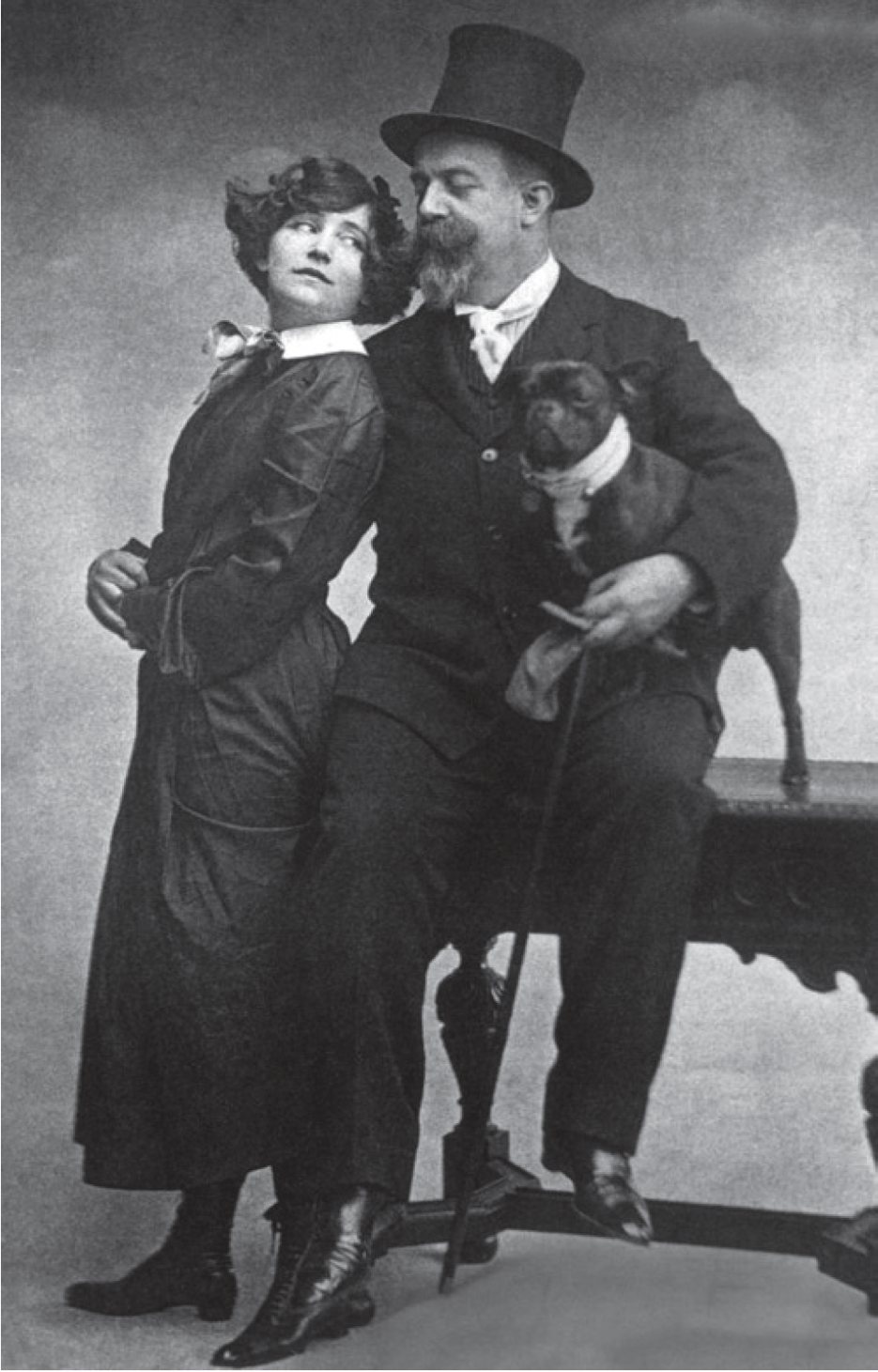
[The now forgotten mass producer of text Willy with his wife, who became the famous writer Colette]
With the rise of the mass media in the nineteenth century, writers changed from poets and playwrights to journalists and novelists. Introducing steam-powered presses made it possible to print newspapers - and books - quickly and in huge print runs. Media that had existed for centuries, such as newspapers, were transformed thanks to technology into mass media intended for a wide audience. To entertain the newspaper readers and entice them to buy the next issue, many novels initially appeared as serial novels. In the nineteenth century, French readers were addicted to feuilletons. Writing them required a special gift: to be able to deliver a piece every day that must be of a certain length, but with a plot that carries the whole book and that also ends each day in such a way that the reader waits at the newsstand the next day for the next installment. Alexandre Dumas is a famous example of such a talent. It is obvious that in a century when everything was about industry, writing could also become an industry. Some writers, such as the now-forgotten French writer Willy - infamous only as Colette’s first husband - had veritable studios where one servant devoted himself to descriptions of nature and another to conversations. Much in the same way that the apprentices of painters like Rembrandt in the Golden Age painted hands or trousers so that the master could deal with composition and faces.
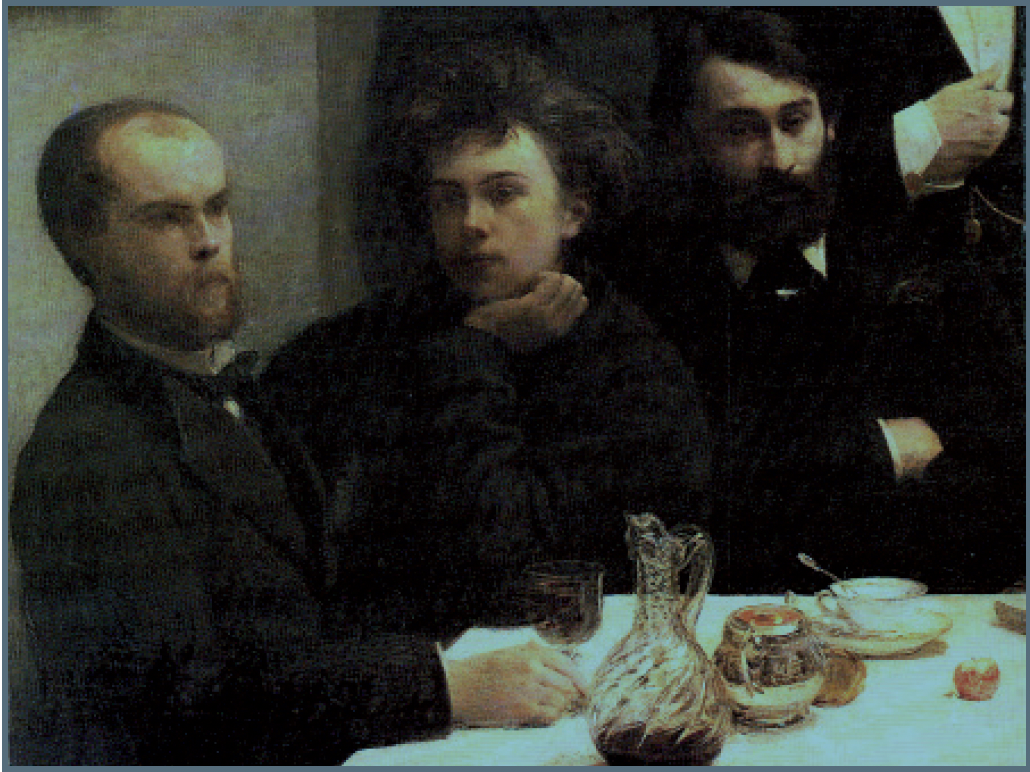
[Paul Verlaine and Arthur Rimbaud]
On the other hand, there were writers who consciously chose an existence outside the established order, for the bohemia. Arthur Rimbaud had his debut printed himself and the entire print run ended up unread in his printer’s Brussels attic. Anyone who puts the earliest editions of Paul Verlaine next to the collections of his contemporary Robert de Montesquiou - “by whom?” you ask now but in his time he was quite famous and readers of Proust know him as Baron de Charlus - sees better than in all biographies what price such writers paid. Verlaine’s early printings are rags, poorlyy printed on the cheapest paper available. Montesquiou’s books have beautiful bindings and fine illustrations. They are expensive books that you can easily give as a gift to a baroness friend or leave lying around in an elegant salon!
Of course, the bohemian’s confusion of bohemian life with talent also caused misery. Drinking and writing in pubs does not guarantee immortal masterpieces. But neither does the reverse.
There is a greater symbiosis between the writer and the publisher today than ever before. Publishing houses have become well-oiled machines. Expert editors help the writer with his spelling and sometimes even with his plot. This is so that the writer sometimes looks more like the creator of a semi-fabricated play, or like an opera composer, who, after all, depends entirely on the quality of the singers, the orchestra, and the director.
The publisher does his part to bring an attractive book to the public’s attention. He also takes care of his writers, for instance, by bringing them to the media’s attention. The writer’s personality is not fundamentally relevant to his work, which is, or should be, autonomous but publishers and the public think otherwise. Nowadays, the writer has to become a well-known personality. Sometimes the writer almost completely disappears behind his public persona. Every Dutchman knows the poets Jules Deelder and Bart Chabot, but do they read their poems? Is public display essential to selling books? Some authors cherish the opposite image: J.D. Salinger. Salinger in particular remained in the news because of his dogged privacy protection.
What the future holds for writers cannot be predicted. This is at least not by those who, like me, have already heard three times that dethe novel is dead and that printed books are dying. So far, I have not read one single prediction about the future of writing or the book that has come true. On the other hand, we have been living in the digital age for years and some trends may affect writing development. Unfortunately, despite all the courses and helpful advice, writing has not become easier. You can see this very well on websites where aspiring writers share their joys and sorrows. They toil endlessly on their texts and wonder why they keep getting rejected. They take courage from the fate of writers like J.K. Rowling, who found a publisher after a hundred rejections and is now the richest writer in the world.
For writers for whom it is more meaningful to express themselves than to be read en masse and make money, the internet is a godsend. Then you write that text of a few hundred words at a café table and polish your language until every sentence is a shining pearl. And you publish it on your beautifully designed blog. You have five readers, or fifty. Who knows, maybe one day you will be noticed by another author with many more readers. The Internet has gatekeepers. They call themselves ‘curators’ and collect what’s new and cool, often having hundreds of thousands of followers. And then one morning you looked at your blog’s figures and found ten thousand readers. It happens. But it has nothing to do with the book anymore.